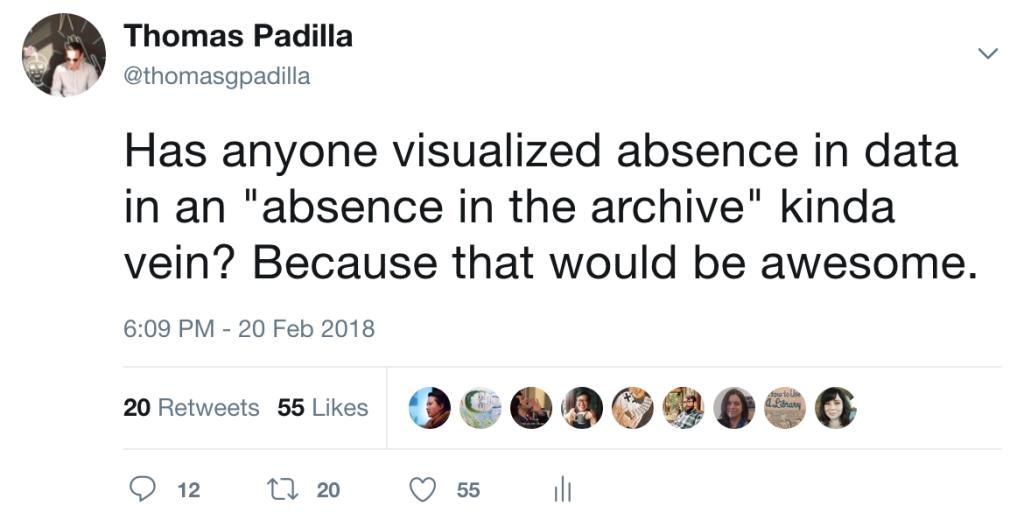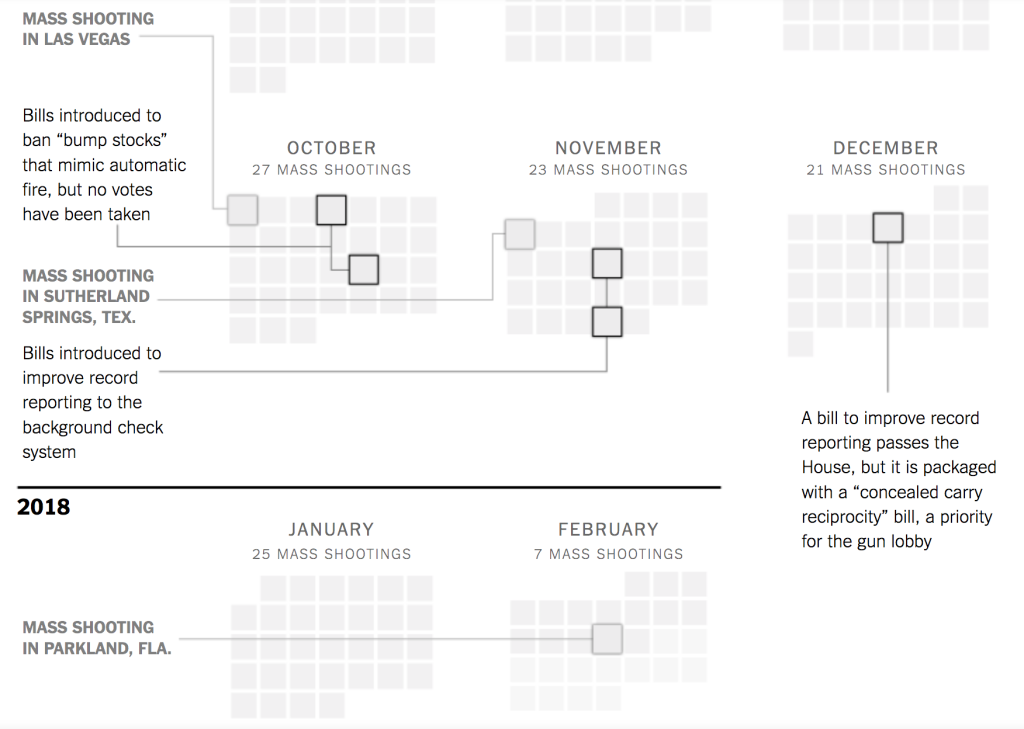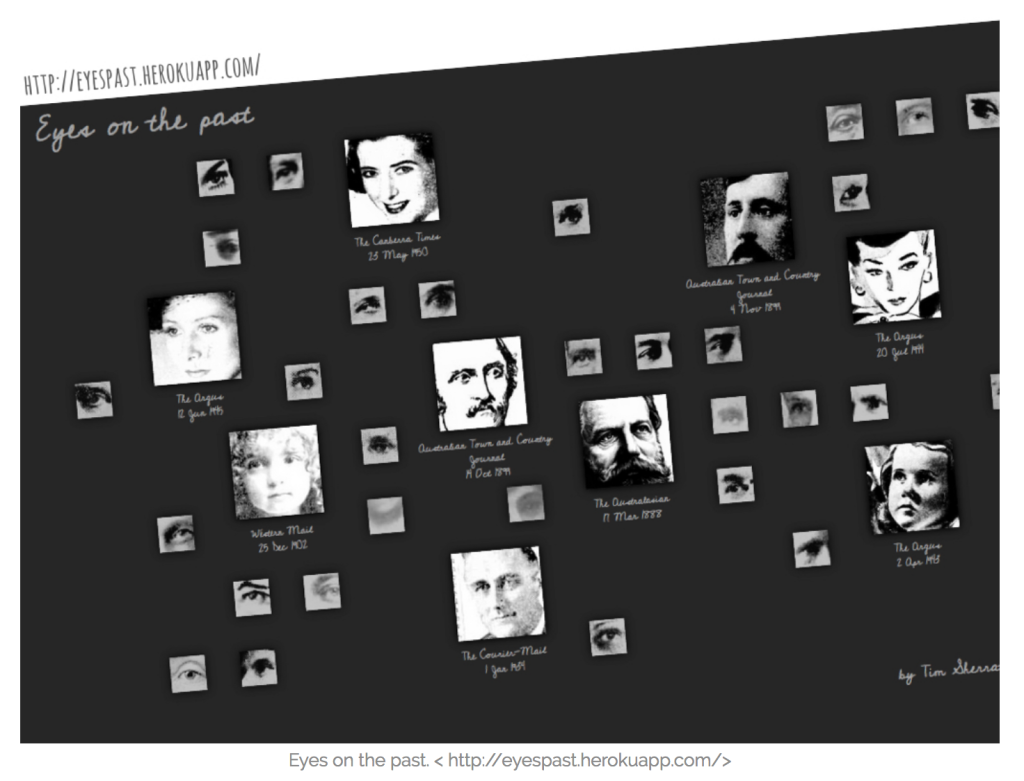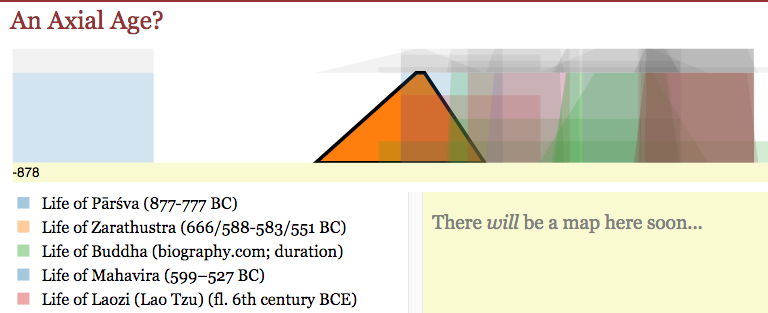refuse the old means of measurement.
rely instead on the thrumming
wilderness of self. listen.
out west, donika kelly
In the Digital Humanities, it is common to weigh the research potential of collections as data by evaluating their representativeness. That is to say, we ask to what extent the data have the capacity to characterize a person, an event, a period, or an experience. Where the data exhibit significant informational paucity, indeterminate values, inordinate biasing, or limited scope it is common to cast them aside in pursuit of something held to be more representative. Alternatively, a move is made to systematically qualify data absence as a means of shoring up grounds for a redefined notion of representativeness to stand upon. Both responses generally fail to engage with data absence as a feature rather than a bug to be quashed. How might data driven scholarship be conducted in a manner that centers data absence?
I turned to Twitter with a question in this vein and did my best to document the generous response below.
Amalia S. Levi shared Lauren Klein’s The Image of Absence: Archival Silence, Data Visualization, and James Hemings. With this piece, Lauren (1) demonstrates how Digital Humanities techniques can be used to address archival silence (2) and frames challenges that an archive of slavery poses for the Digital Humanities.
Scott Weingart referred to absence as, “more a creative wellspring than a lacuna”, and shared a concise presentation on Fidelity at Scale. Scott raised the notion of a workshop or conference focused on productive explorations of archival absence at scale. I am all in for that. I’d guess that others would be to.
Jer Thorp shared Mimi Onuoha’s On Missing Datasets. With this project, Onuoha calls attention to, “blank spots that exist in spaces that are otherwise data-saturated.” Onuoha is careful to emphasize that “missing” should be understood as, “a lack and an ought: [a space where] something does not exist, but … should.” Onuoha goes on to introduce social factors that can be used to understand why data might not be accounted for. It should come as no surprise that these factors are arrayed against the most vulnerable among us. As a speculative exercise in seeing what isn’t there, Onuoha provides “an incomplete list of missing datasets.”
Ryan Dunn introduced the work of Andy Kirk. Andy shared a presentation on The Design of Nothing. In this presentation Andy provides a principle driven exploration of how to produce data visualizations where, “what is not happening is just as relevant as what is“. It is a kaleidoscopic presentation.
On that note, Gregory Palermo shared a New York Times Op-Ed, What Congress Has Accomplished Since the Sandy Hook Massacre. Data absence is deafening.
Jacqueline Wernimont shared Morris Eaves The Editorial Void: Notes toward a Study of Oblivion. Eaves presents a lengthy discourse on how to work with a history that, “even in the best imaginable circumstances, comes down edited by the harsh disciplines of purposeful and accidental forces.”
Mitchell Whitelaw flagged the notion of “intrinsic / representative incompleteness” raised by Tim Sherratt’s Seams and edges: Dreams of aggregation, access & discovery in a broken world. In this piece, Sherratt works against the perception of a seamless experience on the web in order to help us see how various people, data, and systems come together to constitute it – an exercise in finding the seams. With recognition of seamful experience in place, Sherratt asks, “What might happen if instead of seeing the seams and edges of our information landscape as speed bumps in the onward march of progress we recognized their fragility, and celebrated them as sites of collaboration, negotiation and repair?”
Clemens Neudecker shared his and Alastair Dunning’s Representation and Absence in Digital Resources: The Case of Europeana Newspapers. Clemens and Alastair present challenges they encountered addressing absence in the context a large scale historic newspaper digitization effort. How might a user interface for newspapers visually represent absence? How might the user ascertain the representativeness of a subset of digitized newspapers relative to all known holdings – digitized and not digitized?
Cole Crawford and Karl Grossner both reminded me of the amazing work of Stanford’s Center for Spatial and Textual Analysis (CESTA). CESTA tools like Breve and Palladio help users identify absence in data. This interaction also offered occasion to give a shoutout to Karl’s work with representation of indeterminate temporal data.
Anna Neatrour indicated that the question of absence would be interesting to explore in the context of Native American collections at her institution, where named people are typically members of the Bureau of Indian Affairs or Missionaries. Guha Shankar suggested that field notes from this period are limited and proposed a strategy of collaborating with descendants of source communities. Kim Christen noted that, “Absence is assumed, but may also be willful not seeing that is at play”.
Collectively, these examples evidence promising directions in treating data absence as an integral feature rather than a bug to be quashed.
In Donika Kelly’s words they, “refuse the old means of measurement.”
May the refusal flourish.





Nice roundup, Thomas. This prompt and many of these pieces reminded me of Rodney Carter’s “Of Things Said and Unsaid: Power, Archival Silences, and Power in Silence.” Which is a real classic work ideas of the power to and the power of silences in archival collections. You can download the article here: https://archivaria.ca/index.php/archivaria/article/viewFile/12541/13687
“Without a doubt, we must open our ears to the unsaid which rests in the gaps in discourse…” – Jacques Lacan, who was really writing in the context of the conscious vs unconscious. Your examples of the unseen and absence reminded me of the unsaid and the unheard and thus Lacan’s writings on the topic.
Thanks so much for this post, and the list of readings Thomas! It’s great to see them gathered in one place.
Data absence is definitely something that has been guiding us in the Documenting the Now project. I’m specifically thinking about the work we’ve done around sharing tweet identifier datasets. For some, these datasets are next to useless because of their ephemerality, and the fact that the data can change or even be deleted over time. But for others they are a window into the archival sliver, which provides a shifting view into the past that takes into consideration the wishes of the content creators. It’s not a perfect mechanism, but it’s also not meant to be perfect.
Here are a couple readings that came to mind while reading your list:
Verne Harris. The archival sliver: Power, memory, and archives in South Africa.
https://link.springer.com/article/10.1007/BF02435631
John Cage. Silence: Lectures and Writings.
https://www.goodreads.com/book/show/765651.Silence
Thomas, a few years ago there was a conference hosted by the Centre for Editing Lives and Letters specifically discussing failure (and by extent, absence) in archival research: https://failureinthearchives.wordpress.com/, which offers some reading too.
(looking forward to meeting you this week!)
I’m gonna join the fun and drop a link to the project that got the #xpmethod crew thinking about data as absence: “Delivering post by foot in medieval North India” by Emily Fuhrman, Manan Ahmed & Jeremiah Christensen:
http://emilyfuhrman.co/interactive/F2015002/
Keep the links coming guys! And thanks, Thomas for this wonderful start!
Thank you for inquiring and for the list you’ve shared, Thomas! I’d like to add a book by Marisa J. Fuentes, Dispossessed Lives: Enslaved Women, Violence, and the Archive, where she provides both a method and model for reading silences in (not in) archives by reading along the bias grain.
Her book: http://www.upenn.edu/pennpress/book/15502.html
And a Q&A about her work: https://earlyamericanists.com/2017/05/15/qa-marisa-fuentes-dispossessed-lives/
Thanks for this great post! I’ve been grappling with this in ninteteenth-century Latinx Studies and recently published an article on the topic: “Toward a Latinx Digital Humanities Pedagogy: remixing, reassembling, and reimagining the archive” https://tandfonline.com/doi/full/10.1080/09523987.2017.1391524